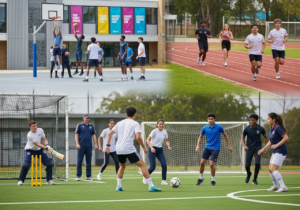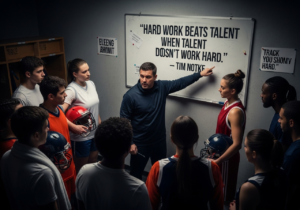What Kids Learn About Leadership from Team Sports

In an age dominated by screens and digital distractions, team sports remain one of the most effective ways to teach kids real,world life skills and among the most valuable of these is leadership. Whether they’re playing cricket at school, football in the neighborhood park, or basketball in a coaching academy, children experience the building blocks of leadership in action when they participate in organized team sports.
But leadership isn’t just about being the captain or calling the shots. It’s about communication, responsibility, empathy, strategy, and resilience all of which are cultivated on the sports field. In this blog, we’ll explore how kids learn leadership through team sports, why this development is crucial, and how parents and coaches can encourage it in everyday play.
Why Team Sports Are the Ideal Training Ground for Leadership
Unlike individual sports or classroom group projects, team sports mimic real,life leadership scenarios in the most dynamic way possible. Players need to make quick decisions, rely on teammates, take responsibility for outcomes, and lift others up after setbacks all while keeping their eyes on the goal.
Here’s why team sports stand out:
- They involve shared goals, where success depends on collaboration.
- Every player, regardless of position, has a role that affects team performance.
- There’s constant feedback and adjustment, much like in real,world leadership roles.
- Kids experience both leading and being led, which is essential for balanced development.
Let’s dive into exactly what leadership lessons kids learn on the field.
1. Communication Skills: Speaking Up & Listening Well
In any sport, clear communication is key. Whether it’s calling out for a pass in football or coordinating a defensive strategy in hockey, children must learn how to communicate confidently and clearly even under pressure.
Leadership is about more than giving directions; it’s about creating mutual understanding and trust. Through team sports, kids learn:
- How to express their needs quickly and respectfully
- The importance of non,verbal cues (hand signals, eye contact, body language)
- When to speak, and when to listen
- How to give constructive feedback without discouraging others
Leadership takeaway: Great leaders talk less, listen more and speak when it counts.
2. Accountability: Owning Up, Bouncing Back
One of the first things team sports teach kids is that their actions affect others. If a player misses a pass or fails to defend, it doesn’t just affect their personal record it affects the whole team. This is a powerful early lesson in accountability.
Children learn:
- To take responsibility when they mess up
- That it’s okay to make mistakes, but important to learn from them
- How to apologize and move forward
- That showing up consistently is part of being a dependable team member
And when they win, they also learn to celebrate together, not alone.
3. Decision,Making Under Pressure
Game situations are unpredictable. In a tight match, kids often have just seconds to decide what to do whether to pass, shoot, or hold possession. These moments help children practice quick thinking and learn the value of smart, strategic decisions.
They also learn that:
- Every decision has consequences, and it’s okay if it doesn’t always work out
- Leaders take calculated risks, not impulsive ones
- Staying calm under pressure is more powerful than panic
Want your child to get more comfortable making these decisions on the field? Regular exposure through practice matches and training helps. Book your next session on KheloMore and get them ready.
4. Teamwork: The Foundation of Leadership
One of the most beautiful aspects of team sports is that no one can win alone. Kids begin to see how different skills and personalities contribute to success. This not only makes them better teammates, it teaches them to become inclusive, team,and first leaders.
They learn:
- How to recognize strengths in others
- Why every player, even on the bench, matters
- How to motivate struggling teammates
- The art of sharing credit and uplifting the group over individual glory
Leadership in action: Being the one who lifts others up after a tough loss or celebrates even the smallest teammate victories.
5. Emotional Intelligence and Empathy
Real leadership goes beyond tactics; it’s emotional. Through the highs and lows of wins and losses, kids develop empathy, self,awareness, and emotional regulation.
On the field, kids experience:
- Frustration, anxiety, and excitement all in one game
- The emotional toll of letting a team down or losing a game
- How to console teammates or keep spirits high when morale drops
- Patience and compassion for different learning curves
These are the traits that create great leaders in business, community, and life.
6. Conflict Resolution: Handling Differences Respectfully
Disagreements happen all the time in team sports. Someone didn’t pass the ball, another ignored the strategy. Kids inevitably face conflict, and with guidance, they learn how to:
- Express disagreement respectfully
- Resolve disputes without blaming
- Mediate between peers
- Understand multiple perspectives before reacting
This prepares them to be mature, solution oriented leaders as they grow.
7. Leading Without Authority
Here’s a powerful lesson from sports: you don’t need to be the captain to lead. Kids often lead in subtle ways:
- Helping a teammate stretch
- Reminding the team of warm,up routines
- Setting a good example through behavior
- Organizing group huddles or post,game cheers
These “unofficial leaders” often make the most lasting impact. Encourage your child to be that player, regardless of their title.
Try this: Ask your child how they supported a teammate today. Leadership starts with small acts.
8. Vision and Goal Setting
Every team starts the season with a goal: win the tournament, make it to finals, improve fitness. Kids learn how to align their efforts to long,term goals and track progress over time.
They develop:
- A sense of purpose beyond just playing
- Consistency and focus, day after day
- The ability to reflect on past performance and improve
- Vision,setting skills that help in academics and life
You can build this habit further by setting weekly or monthly training goals and tracking them. Use platforms like KheloMore to schedule regular sessions and make goal setting part of the training journey.
9. Discipline and Time Management
Balancing practice, school, and playtime requires kids to manage their schedules. They learn that to lead others, you first need to manage yourself.
Team sports instill:
- Punctuality and preparation habits
- Commitment to practice even when tired
- The balance between work, rest, and fun
- A clear sense of responsibility to the group
10. Resilience: Bouncing Back Like a True Leader
Every athlete faces failure, missed goals, unexpected losses, injuries. These tough moments are when leadership is truly tested. Kids learn to:
- Accept setbacks without giving up
- Encourage themselves and their teammates
- Build grit and determination
- Come back stronger, every time
Life lesson: Leaders don’t avoid failure. They grow from it.
Final Thoughts: The Future Leaders Are on the Field
In a world that values soft skills, adaptability, and emotional intelligence more than ever, team sports remain a vital leadership incubator for kids. The field teaches what books often can’t lead by doing, by feeling, by failing, and by rising again.
Whether your child dreams of captaining a national team or just wants to play better with friends, the leadership lessons they learn through sports will stay with them forever. Ready to get your child on the path to leadership? Book your next session through KheloMore and give them the opportunity to grow on and off the field.




